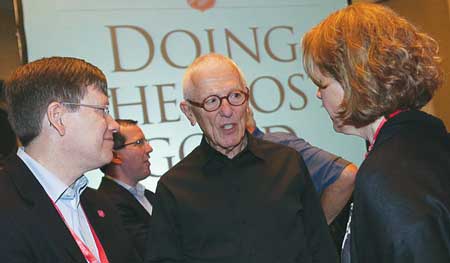2007 to be largest year of participation to date.
by Christin Davis –
The idea for a short-term summer mission program, Service Corps, developed in 1966 to provide young Salvationists an opportunity to serve people around the world. Now—over 40 years later—as the program has grown and developed, the Western Territory received more applications in 2007 than ever before.
“This is an exciting year considering the amount of quality participants we have,” said Jim Sparks, youth development and leadership director at THQ, who coordinates Service Corps. “This is a year that will put Service Corps on the next level.”
For six weeks this summer, 40 young adults, ages 18-25, will represent the Western Territory on four continents, serving the Army in various capacities.
The small teams focus their service on meeting the needs of a designated location, which can include leading worship services, running day camps and vacation Bible schools, preaching, teaching English, doing community work, conducting outreach activities and completing maintenance projects.
development for many of the young adults who serve,” said Sparks.
From then to now
In the 1970s there was a shift to urban ministries in Service Corps; eventually teams of 12 traveled to Alaska and Hawaii along with the mainland work in the divisions. In 1984 the service-oriented program transformed into the Hallelujah Road Show—a traveling evangelistic team—until 1988 when teams were again sent out of the United States.
This year, the road show has returned. A team of eight will travel up and down Interstate 5, from Seattle to Tijuana, stopping in 13 cities along the way to perform a mixture of music, drama and interactive elements for corps’ evening programs, vacation Bible schools and Sunday services. The group will meet at orientation and begin rehearsing, after working with a performance group, One Time Blind, at commissioning. Their schedule will soon be available online at sayconnect.com.
In addition to the road show, five teams will work overseas.
A team of six will travel to South Africa, participating in a youth conference and joining with Army mission teams there for home visitations. The team will spend three weeks in Mozambique and three weeks on the outskirts of Johannesburg.
A team of six will travel to China to run youth programming, teach English camps and do street preaching at three corps in Hong Kong.
A team of six will travel to Argentina, completing a variety of work projects on corps buildings and Army program facilities during their six-week stay.
A team of six will travel to Brazil, focusing on youth programming at different corps.
A team of two will travel to, as of yet, an undecided location to work in an Army-run hospital as nurse interns. Both are working towards degrees in nursing and will receive school credit for their work.
The territory will also deploy two urban teams this summer—one team of four will be sent to Seattle, Wash., to work in the “StreetLevel” urban ministry program run out of the Seattle Temple Corps and another team of two will work as camp directors for King’s Lake Camp in Alaska.
“Missions are often associated with going overseas but we cannot forget the strong mission field we have in our backyard as well,” Sparks said. “Missions are everywhere—we don’t want to lose sight of that.”
Preparing for summer and beyond
Each team member is responsible for raising $1,500 before June. Upon returning, participants receive a $2,000 educational grant and this year, an additional $1,000 educational grant will be distributed in January to those participants who meet specific requirements within their home corps in the months following summer.
“We are trying to further cement our belief in the importance of corps programming,” Sparks said. “Service Corps doesn’t stop after summer—it’s a training ground for a lifetime commitment of involvement and activity in the corps.
“We want the teams to have a cultural experience and gain a better knowledge of what the Army is doing in all parts of the land and then bring that back to their corps—to get other people excited about missions and about the Army,” Sparks said.
Orientation will begin in June, as team members participate in the commissioning events—connecting with other young adults to promote territorial events and running childcare—followed by a week of training before the adventure begins. Teams leave California on June 15.
During their six-week service, each of the teams will be periodically posting stories, experiences and photos on the service corps blog—accessed through sayconnect.com or directly at saservicecorps.blogspot.com.











